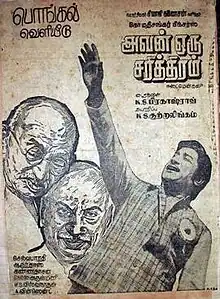| Avan Oru Sarithiram | |
|---|---|
 Theatrical release poster | |
| Directed by | K. S. Prakash Rao |
| Screenplay by | G. Balasubramaniam |
| Story by | Selvabharathi |
| Produced by | K. S. Kutralingam |
| Starring | Sivaji Ganesan Manjula Kanchana |
| Cinematography | A. Vincent |
| Edited by | R. Devarajan |
| Music by | M. S. Viswanathan |
Production company | Gomathi Sankar Pictures |
Release date |
|
| Country | India |
| Language | Tamil |
Avan Oru Sarithiram (transl. He has made history)[1] is a 1977 Indian Tamil-language film directed by K. S. Prakash Rao and produced by K. S. Kutralingam. The film stars Sivaji Ganesan, Manjula and Kanchana.[2] It was released on 14 January 1977.[3]
Plot
Shankar, his brother Muthu, their father Namachivayam, mother, Lakshmi, sister Gowri, betrothed Gomathi, all live in a well-to-do happy family. Shankar becomes a collector to fulfill his father's desire while Muthu became a farmer and turns into a revolutionary, seeing the atrocities committed by the corrupt politicians and officials.
Gowri falls in love with Ramu, son of Vedhachalam, a businessman who is married for the second time to a young woman and has his father-in-law as his guide. Vedhachalam intends to use his connection to the family to get a few files signed and some properties belonging to the government acquired in his name. The honest upright Shankar insults him causing a rift between the two families. Vedhachalam, having felt insulted, wants to take vengeance by ruining the family. He aims to acquire all the land belonging to Namachivayam to whom his land is as sacred as his own mother. He becomes an M.L.A, uses his influence and gets the land acquired through Shankar in his capacity as collector with the excuse that it is ideal for TB hospital. He later subverts the collector and gets it allotted for his purpose. This causes Namachivayam to die and Shankar to resign. He starts a magazine to expose the corrupt nexus above him with the support of Kalpana, Vedhachalam's foreign-educated doctor daughter who cannot bear to see her father's evil activities.
In the end, seeing the influence of Shankar as a journalist grow, he attempts to kill him only to end up killing his own daughter for which he and his cohorts are arrested. Seeing that violence begets violence, Muthu too surrenders.
Cast
- Sivaji Ganesan as Shankar I.A.S, Sub Collector
- Manjula as Gomathi, Shankar's lover
- Kanchana as Kalpana
- T. K. Bhagavathi as Nattamai Namachivayam, Shankar's father
- Pandari Bai as Lakshmi, Shankar's mother
- Srikanth as Muthu, Shankar's brother
- Major Sundarrajan as Head Collector
- S. V. Ramadas as Collector Secretary
- K. A. Thangavelu, Vedhachalam's uncle
- V. K. Ramasamy as Vedhachalam
- Manorama, Vedhachalam's Second wife
- Cho as Ramu, Vedhachalam's Son
- M. Bhanumathi as Gowri, Ramu's wife and Shankar's sister
- C. I. D Sakunthala as Dancer
- Karuppu Subbiah
Soundtrack
The music was composed by M. S. Viswanathan.[4] The song "En Manadhu Ondrudhaan" is partially based on "Für Elise" by Ludwig van Beethoven.[5] The song "Ammaanai" is set in Dharmavati raga, and "Vanakkam" is set in Abhogi.[6][7]
| Song | Singers | Lyrics | Length |
|---|---|---|---|
| "Aayiram Ponnai" | M. S. Viswanathan, Nellai Ganapathy | Nellai Arulmani | 03:13 |
| "Ammaanai" | T. M. Soundararajan, Vani Jairam | Kannadasan | 04:45 |
| "Vanakkam" | T. M. Soundararajan, P. Susheela | 05:57 | |
| "Maalaiyittaan" | T. M. Soundararajan, Vani Jairam | 03:19 | |
| "Naalai Enna Naalai" | T. M. Soundararajan | 03:16 | |
| "Inikkum Kannangal" | L. R. Eswari | 03:12 |
Reception
Kanthan of Kalki appreciated the cinematography, but criticised the story.[8]
References
- ↑ Baskaran, S. Theodore (2008). Sivaji Ganesan: Profile of An Icon. Wisdom Tree. p. 95. ISBN 978-81-8328-396-0.
- ↑ "181-190". nadigarthilagam.com. Archived from the original on 26 August 2014. Retrieved 21 August 2014.
- ↑ "நடிகர் திலகம் சிவாஜி கணேசன் அவர்கள் நடித்த படங்களின் பட்டியல்". Lakshman Sruthi (in Tamil). Archived from the original on 14 August 2016. Retrieved 21 April 2023.
- ↑ "Avan oru Sarithiram Tamil Film EP Vinyl Record by M.S.Viswanathan". Mossymart. Archived from the original on 10 July 2021. Retrieved 7 July 2021.
- ↑ Srinivasan, Karthik (9 October 2018). "What Connects Anu Malik, M.S. Viswanathan And Rajesh Murugesan To Beethoven?". Film Companion. Archived from the original on 13 October 2018. Retrieved 13 October 2018.
- ↑ Mani, Charulatha (2 March 2012). "A Raga's Journey — Arresting Abhogi". The Hindu. Archived from the original on 6 October 2018. Retrieved 28 September 2020.
- ↑ "Know your raga: Abhogi – It rouses your spirit". News Today. 11 December 2018. Archived from the original on 7 July 2021. Retrieved 7 July 2021.
- ↑ காந்தன் (23 January 1977). "அவன் ஒரு சரித்திரம்". Kalki (in Tamil). p. 63. Archived from the original on 28 July 2022. Retrieved 28 July 2022.